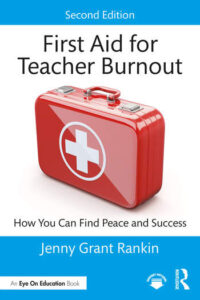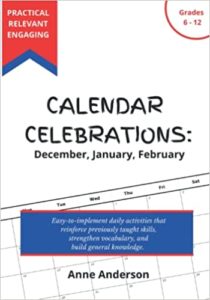Effective First Aid to Quash Teacher Burnout
First Aid for Teacher Burnout: How You Can Find Peace and Success, Second Edition
By Jenny Grant Rankin
(Routledge/Eye On Education, 2023 – Learn more)
Reviewed by Anne Anderson

First Aid for Teacher Burnout is suitable for both preservice and veteran teachers. Readers may recognize themselves or possibly a colleague in the Teacher Confessions from people like Linda Hand, Alotta Marx, Justin Tyme, or Anita Break.
Research and Reflections

Dr. Rankin begins Chapter 1, Help Is on the Way, with a dictionary definition of burnout plus a list of ways it can manifest itself in teachers’ lives: (p. 4)
- Detachment from work, personal life, or what is going on around oneself (might include chronic absenteeism)
- Cynicism or apathy
- Feelings of hopelessness, uselessness, or lack of accomplishment
- Irritability
- No longer enjoying experiences (like turning down social gatherings)
- Declining productivity or performance on the job
- Emotional or physical exhaustion
- Changes in sleep and/or physical appearance
Here’s one teacher’s description of her burnout: “I used to feel competent and hopeful about my work, but now I feel drained of the energy to overcome its challenges.” (p. 4)
This first chapter includes statistics and research to support the author’s claim of a teacher burnout pandemic, which has only intensified since COVID. Included in this chapter are three self-assessments teachers can take to determine whether they are experiencing burnout. Subsequent chapters focus on major areas of stress and how to avoid or alleviate that stress.
What Teachers Can Do
In Chapter 2, Mindset and Wellbeing, the author reminds teachers to be proactive: Avoid Toxic Traps and Amend Toxic Thinking. Her suggestions include some basic life lessons – stay away from the complainers, recognize what you can control and what you can’t, and find something to laugh about.
Looking for ways to take control of your work environment? That’s Chapter 3! The author suggests that we begin by looking at our classroom to see if it fits any of the following descriptions: (p. 41)
- The room looks messy or cluttered.
- Posters/visuals are too juvenile or outdated.
- There’s just something depressing about the space.
- I can’t always find what I’m looking for, or it takes me too long to find items.
- I haven’t changed the majority of what’s on the walls in a long time.
- The arrangement doesn’t suit some of the activities or processes I want to use with my students.
- The room doesn’t promote my students’ academic and behavioral growth.
As with our closet at home, there comes a time when we must “clean and purge.” Getting rid of those piles and that stuff you no longer use will make you feel better; plus, it benefits your students who are easily distracted. The suggested solutions are all manageable and will reduce your stress. Use the tips and strategies that are applicable to your circumstances.
“If you don’t place restrictions on when and where others can enlist your help, you serve everyone but yourself.” (p. 57) In Chapter 4, Overstimulation, the author addresses three topics: setting boundaries for others, setting boundaries for ourselves, and employing systems and tools. Allow your brain to rest by implementing some of Rankin’s tips.
Because burned-out teachers are less effective teachers, the author reminds us to let go of perfectionism and set realistic goals each day. Teachers can set themselves up for success by practicing these strategies from pages 126 – 127:
- Preconceive a “no” statement you find comfortable and willing to use.
- Require and take time to think if you need it.
- Determine when a “yes” is OK.
- Pull out where you can.
Putting a Face on Stressors
Because stress comes from a variety of directions, in Student Behavior (chapter 11), Administration (Chapter 12), and Parents (Chapter 14) Rankin includes strategies for specific problems that may arise. A teacher in the middle of a crisis with one of these three groups can benefit from reading the appropriate chapter. Routledge provides nine additional downloadable resources on their website to help you tackle burnout.
Before you walk away from your calling, read First Aid for Teacher Burnout, Second Edition. If you are struggling with burnout, depression, anxiety, seek professional help. Peace and success can be yours.

Calendar Celebrations: December, January, February is part of Anne Anderson’s trilogy on quick, engaging activities and resources for months of the school year. (For MiddleWeb she wrote about selected winter celebrations here, about fall here, and about spring here.) Anne has also published articles in IDEAS Plus and Voices from the Middle, publications of the National Council of Teachers of English. She is a frequent reviewer of professional books for MiddleWeb.com.

































